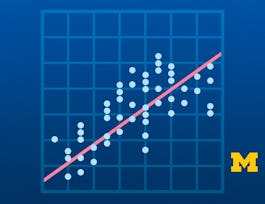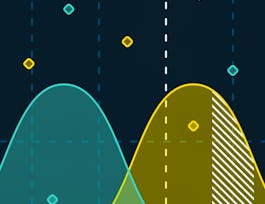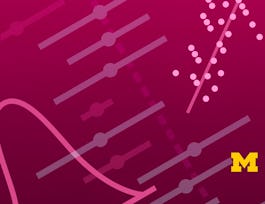This course covers commonly used statistical inference methods for numerical and categorical data. You will learn how to set up and perform hypothesis tests, interpret p-values, and report the results of your analysis in a way that is interpretable for clients or the public. Using numerous data examples, you will learn to report estimates of quantities in a way that expresses the uncertainty of the quantity of interest. You will be guided through installing and using R and RStudio (free statistical software), and will use this software for lab exercises and a final project. The course introduces practical tools for performing data analysis and explores the fundamental concepts necessary to interpret and report results for both categorical and numerical data



Inferential Statistics
This course is part of Data Analysis with R Specialization

Instructor: Mine Çetinkaya-Rundel
Sponsored by EdgePoint Software
120,948 already enrolled
(2,711 reviews)
Skills you'll gain
Details to know

Add to your LinkedIn profile
12 assignments
See how employees at top companies are mastering in-demand skills

Build your subject-matter expertise
- Learn new concepts from industry experts
- Gain a foundational understanding of a subject or tool
- Develop job-relevant skills with hands-on projects
- Earn a shareable career certificate


Earn a career certificate
Add this credential to your LinkedIn profile, resume, or CV
Share it on social media and in your performance review

There are 5 modules in this course
This short module introduces basics about Coursera specializations and courses in general, this specialization: Statistics with R, and this course: Inferential Statistics. Please take several minutes to browse them through. Thanks for joining us in this course!
What's included
2 readings
Welcome to Inferential Statistics! In this course we will discuss Foundations for Inference. Check out the learning objectives, start watching the videos, and finally work on the quiz and the labs of this week. In addition to videos that introduce new concepts, you will also see a few videos that walk you through application examples related to the week's topics. In the first week we will introduce Central Limit Theorem (CLT) and confidence interval.
What's included
7 videos6 readings3 assignments
Welcome to Week Two! This week we will discuss formal hypothesis testing and relate testing procedures back to estimation via confidence intervals. These topics will be introduced within the context of working with a population mean, however we will also give you a brief peek at what's to come in the next two weeks by discussing how the methods we're learning can be extended to other estimators. We will also discuss crucial considerations like decision errors and statistical vs. practical significance. The labs for this week will illustrate concepts of sampling distributions and confidence levels.
What's included
7 videos5 readings3 assignments
Welcome to Week Three of the course! This week we will introduce the t-distribution and comparing means as well as a simulation based method for creating a confidence interval: bootstrapping. If you have questions or discussions, please use this week's forum to ask/discuss with peers.
What's included
11 videos5 readings3 assignments
Welcome to Week Four of our course! In this unit, we’ll discuss inference for categorical data. We use methods introduced this week to answer questions like “What proportion of the American public approves of the job of the Supreme Court is doing?” Also in this week you will use the data set provided to complete and report on a data analysis question. Please read the project instructions to complete this self-assessment.
What's included
11 videos6 readings3 assignments
Instructor

Offered by
Why people choose Coursera for their career




Learner reviews
2,711 reviews
- 5 stars
82.93%
- 4 stars
13.34%
- 3 stars
2.02%
- 2 stars
0.58%
- 1 star
1.10%
Showing 3 of 2711
Reviewed on Jan 7, 2021
The final project does not help, for example someone used discrete data 1,2,3,4,5 .... ,40 to compute a p.value as if it was normal. It is too general and does not fill the purpose of the course.
Reviewed on Sep 8, 2024
It is a very useful course and the learners are able to learn through the videos and the excercises and the lab assignment. I have learnt new things in this course, especially through R
Reviewed on Feb 28, 2017
Great course. If you put in a little effort, you will come out with a lot of new knowledge. I recommend using the book after you have seen the movies. It gives a deeper picture of how it works. Great!
Recommended if you're interested in Data Science

Stanford University

University of Michigan

Universidad de los Andes

University of Michigan

Open new doors with Coursera Plus
Unlimited access to 10,000+ world-class courses, hands-on projects, and job-ready certificate programs - all included in your subscription
Advance your career with an online degree
Earn a degree from world-class universities - 100% online
Join over 3,400 global companies that choose Coursera for Business
Upskill your employees to excel in the digital economy


